Kickboxing is a stand up sport based on a mix of kicking and punching.
Today it is as much a heavy cardio fitness sport than a very efficient striking oriented fighting style.
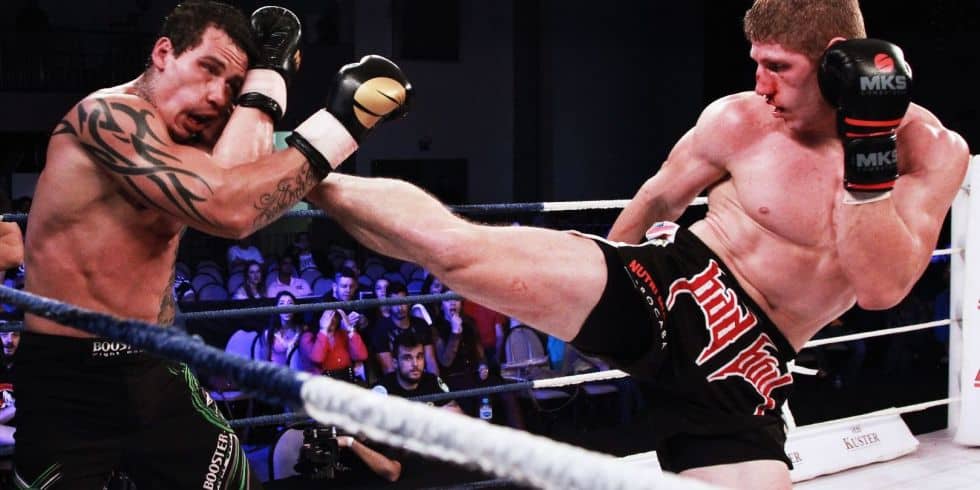
Historically it started as a combination of karate and punching. Nowadays it is considered a hybrid martial art incorporating many different styles. For example Muay-Thai for its kicks, wrestling for its takedown or even Brazilian Jujitsu for the ground work.
Kickboxing philosophy is flexible. It tends to combine what’s best in other martial arts and contact sports. That explains why it’s so largely used in mixed martial arts nowadays.
Today, kickboxing is practiced as a contact sport, for self defense purposes, but also for general fitness. The fact that it uses the entire body promises a big calorie burn in a short time.
The origins of kickboxing are difficult to pinpoint to a precise date as it’s more of a broad term than a precise style.
For example Muay Boran, which developed later into Muay Thai originates from the 18th century. Savate was in vogue in the 1920s in France. Full contact karate competitions were being developed in the 1950s in Japan. In 1962 in the USA kickboxing was designating cross style full contact martial arts tournament.
Styles of kickboxing

Kickboxing is a wide term originating from Japan. It was created by the promoter Osamu Noguchi for a martial art mixing Muay Thai and Karate introduced in 1958.
It designates lots of different styles, which as a rule of thumb are defined by what’s authorized in competition.
- Pradal Serey (or Kun Khmer), originating from Cambodia, looks like Muay Thai but with a bigger emphasis on elbow strikes.
- Muay Boran, ancestor of Muay Thai, was a self defence art incorporating a ground part and deadly techniques. It was used and trained in the military.
- Muay Thai or Thai Kickboxing, modern style thai martial art with an emphasis on clinch, knee strikes and elbows
- Burmese Lethwei, also known as Bando kickboxing, a burmese style allowing the use of headbutt
- Filipino Yaw-Yan, like Muay Thai but differs in the delivering motion of the kick. Its kick does not use hip rotation but rather a downward cutting motion. It also privileges long distance attack.
- Indian Musti Yuddah or Muki boxing, that uses primarely forhead strikes
- French Savate, where only foot kick are allowed (in Muay Thai for example most kicks are made using shin)
- Dutch Kickboxingis a mix of boxing, Muay Thai and Karate
- Full contact karate
- Sanda, Chinese kickboxing that allows throws and takedown
- Shoot boxing, japanese kickboxing in which takedown and standing submission are legal
- Kickboxing is widely used in MMA today, where a fighter has to be able to use almost all his body to be competitive.
Why start kickboxing ?
Starting something new can always be a bit scary. You will not regret it with Kickboxing
Kickboxing for self defense
Kickboxing is a very efficient self defense martial art. It teaches the user to keep long distance with kicks, but also works on close combat using clinch and knees. It gives a good base in both punching and kicking, allowing to have more tools to defend yourself.
Depending on the style you practice you might even learn take down, throws and submission.
If your goal is self defense, it is important that you spar to put yourself in real fighting conditions. Only practicing with a willing partner does not guarantee adequate answers in a real fighting situation. Muscle memory plays an important role in this case.
Why Kickboxing tends to be more efficient than boxing in a street fight / self defense type of situations ?
Body awareness
Kickboxing teaches you to defend against punches, kicks, knees and elbows. Boxing only trains you against punches, giving a smaller defense spectrum.
Distance
With kickboxing you can keep bigger distance with your opponents. It will be a big help if you are fighting against the typical guy that will only throw big punch. It will also help against someone using a weapon.
Defense
In boxing you learn to defend by ducking and waiving, which can be met by a knee / kick in a real fight situation.
To sum things up kickboxing would be better most of the time. It gives you versatility with more attack and defense options. It also gives you the abilities to control ranges better.
Kickboxing for fitness

Big calorie burn
A typical one hour kickboxing class burns between 400 and 700 calories. Most of them are quick paced, mixing cardio calisthenics and techniques. The fact that it uses the full body increases the energy expense and makes it a complete workout. If you are with a good instructor, the movements you do will also change on a regular basis, allowing your body to not get used to the effort.
Core and balance
Every technique in kickboxing uses the core and hips as a foundation. It improves your core strength, but also your sense of stability. Throwing kicks, punches, knees and elbows in precise combination will improve your balance. No matter where your movements originate from they need to follow each other smoothly. Kickboxing trains both anticipatory and reactive balance. You need anticipation when training with someone, and reaction reflexes when sparing with someone.
Coordination and space awareness
Most kickboxing classes require you to train with a partner (using a kick shield or thai pads). You will need to stay focused to intercept your partner’s movements with the type of protection you use. Adapting your range will assure your partner does not injure himself. Being a partner is a skill itself that takes time to master.
Skill building
The movements you practice in a kickboxing class have real life applications contrary to more classic aerobics classes. Of course cardio kickboxing does not make you a fully fledged fighter. But practicing the same movements again and again still build muscle memory. You actually learn techniques while doing a great workout.
Real life conditioning
The diversity of movements practiced during a kickboxing class will transfer to both real life and other fitness activities that you practice.
Cardiac improvement
A typical kickboxing class will alternate high paced and slow paced effort. That will increase both your aerobic and anaerobic capacity. It can be compared to HIIT, increasing VO2 max.
Stress relief
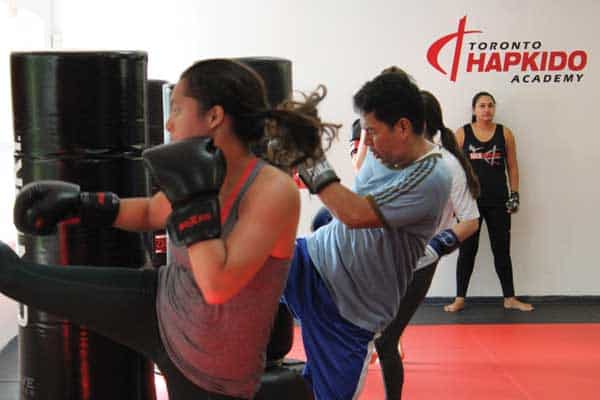
Exercise generally allows you to relieve your stress level. Kickboxing takes it to another level as you can effectively kick your anger away. Picture what makes you feel bad and leave it on the bag at the end of your workout.
Diversity to fight boredom
Kickboxing has a very deep technique repertoire. Every workout can be different, focusing on different parts of the sport each time. It can be a good alternative to a dull workout, that can be efficient but still boring.
Better posture and increase flexibility
Most of the movement in kickboxing originates from the hips. It will allow you to become slowly more flexible in this area. It is even more important if you sit at a desk all day. High kicks and high knees will stretch your groin area and lower back, and punching and knees will help you loosen your upper back and shoulder.
Muscular endurance
Kickboxing will not make you able to bench press three times your body weight or squat 300 kilos. On the other hand it will give you the means to punch or kick non stop for a couple minutes, typically a 5 minute round. This trains your muscled to last longer in everyday situations where you repeat the same movements over and over again. Where bodybuilding trains strength, kickboxing trains power (speed + strength).
Toning
Being such an intense full body workout, kickboxing will tone your entire body.
Anyone can do it
Kickboxing has a very low entry barrier. As long as you give your best you will exert your entire body and increase your fitness class after class. Your typical kickboxing lesson can have a 40 year difference between the youngest and the oldest participant. It’s also a great sport to start if you are overweight as it works your entire body without putting more pressure than your body weight on your joints. Take it slow at first to reduce risk of injuries, listen to your body, and you will see big improvements soon.
Kickboxing as a confidence booster
Knowing that you have some fighting basics in a self defense situation will make you stand taller.
The endorphin release delivered by a kickboxing class will also increase your level of self confidence.
What do you need to start kickboxing?
Most important gear to start
Gloves
The most important item you will need, it is very important to choose them carefully as a bad choice can lead to injuries.
Hand wraps
Close second after the gloves, good hand wraps will keep your wrist locked and avoid a potential sprain.
Shoes
Depending on your gym you might need to wear boxing shoes. Choose the one that is most adapted to your objectives. Boxing shoes, kickboxing shoes and general fitness shoes will be very different.
Optional
Shin guard
Shin protector, very important once you start sparring
Headgear
Mainly used in boxing and MMA sparring, it can be required for kickboxing and Muay Thai too
Mouth guard
This should be mandatory as soon as you are going to get hit. It’s a worthwhile investment to avoid expensive teeth repair.
Techniques
Punching techniques
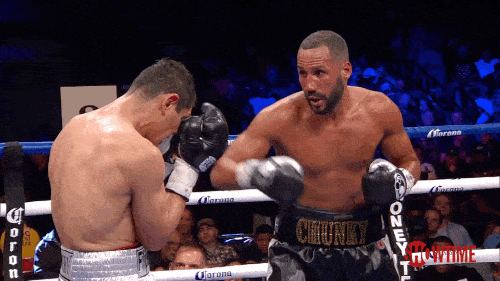
Jab
Same as in boxing, the jab is the most basic punch. It’s a straight punch with your non dominant hand. It’s extremely versatile and can be used to manage distance. Used with a cross (one two), it’s probably the most used basic combination in the sport. It’s the most important punch and should be learned properly by beginners.
Cross
Punch with the backhand, allows the full transfer of the weight of the boxer and is therefore very powerful
Hook
Curved punch aimed at the body or the head. Its rounded trajectory allows it to avoid defense and to be less obvious than a straight line punch. The rotation added by hips and core movement makes it a very strong punch when done properly.
Uppercut
Vertical punch usually aiming at the solar plexus or at the shin. It takes power from both legs and hips and is therefore one of the knock out punches.
Backfist
Used mainly with the front hand as a return punch. Can also be used with the back hand with a spinning motion (360 degrees backfist punch).
Superman punch
It starts by striking from the back hand, jumping and kicking back with the back foot at the same time. Then extend the arm to create more momentum. Very spectacular and powerful punch, it’s a double edge sword. It exposes the fighter to lots of possible counter.
Overhand punch
Mix between a straight cross and a hook. It allows to feint the opponent and goes above most guards. It takes more to execute than a simple hook or a simple cross, leaving you exposed.
Counter
A counter is not so much a technique than a particular context in which the technique is executed. A counter consists of avoiding the opponent punch while punching him or her at the same time. A swift execution will add to your punch the opponent’s weight in addition to your own, making it a devastating punch. It is probably the most powerful punch, but also the hardest to hit as your timing has to be perfect.
Kicking techniques
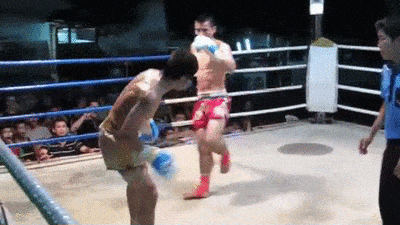
Front kick
Striking with the ball of the foot, usually to the chest or the head.
Teep push kick
Similar to the front kick, also called the foot jab, its goal is to control distance rather than doing serious damage.
Side kick
Kick sideways with legs parallel to the floor in a pushing motion.
Low kick
A circular kick used in a 45 degree angle. It tends to aim for the opponent’s legs, on the inside to catch them off balance or on the outside as a long lasting shot. It is a body blow in this manner.
Roundhouse kick
The most famous kick of kickboxing is a circular kick with a chopping motion. It is inflicted with either the foot or the shin. One of the most powerful kicks as it’s powered by the hips in a rotating motion
There are lots of variations of this kicks, with different impact points, jumping, flying, reverse …
Knees and elbows

They are used in the Japanese variation of kickboxing which takes Muay Thai as ancestor. They are also present in the more full contact oriented variation of kickboxing, such as the one used in MMA.
Straight knee
Long range knee going for the opponent’s stomach or groin. Can also be aimed at the opponent’s head in a clinch situation.
Flying knee
Jumping knee, can be aimed at anything.
Hook knee
Knee with a circular chopping motion aiming at the ribs.
Side knee
Used in a clinching position to hit sideways targeting sensitive joints.
Side elbow
Most used elbow, very common in Muay Thai. It can be used either as an impact damage kind of strike like a cross, or with less penetration for a cutting motion.
Upward elbow
Used in clinch to target the opponent’s face.
Downward elbow
Elbow in a descending manner. It can be used to counter a take down attempt, a failed clinch, or in a flying motion.
Defense
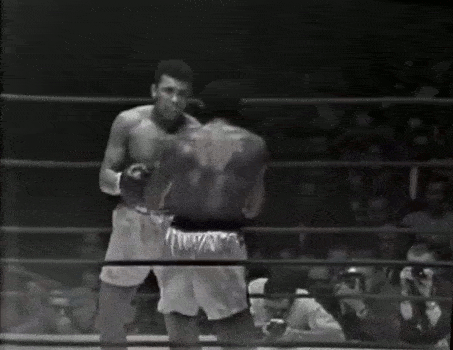
Clinching
It happens when the two opponents have closed the distance between each other. Usually tying up their hands behind their opponents neck, the goal is to control your opponent’s body. It’s usually followed by short and compact punches or knees. In some kickboxing variations this can be used as an entry for a take down.
Cover up
The “turtle” defense position, using your hands to act as a shield to protect yourself from incoming shots. In this position hands need to be in contact with the zone needing defense to avoid punching yourself.
Slipping
Slipping consists of rotating the body for a punch to slip through. It’s a very advanced and very efficient form of defense that requires a good understanding of timing. Muhammad Ali was famous for his slipping defense.
Bob and weave
It is avoiding your opponent’s incoming punch by a constant movement of weaving sideways and bobbing up and down. This defensive movement can be used as a counterattack opportunity. The liver blow for example mainly departs from a bob and weave movement.
Parry / block
Using hands and legs to parry and deflect incoming attacks. For example against a cross punch you can just push down your opponent’s gloves, and use your legs to “check” an opponent’s low kick.
Leave a Reply